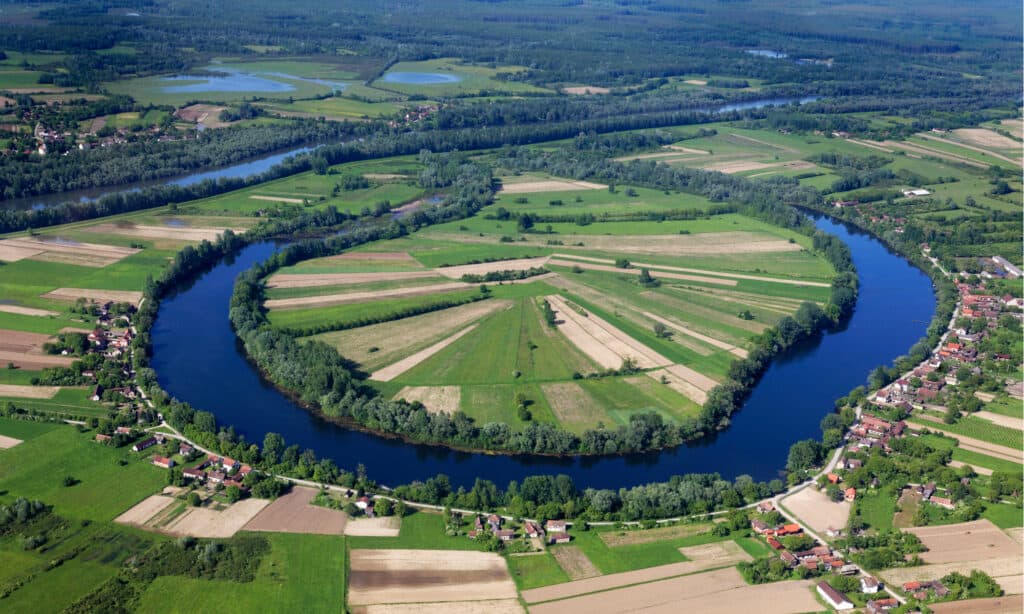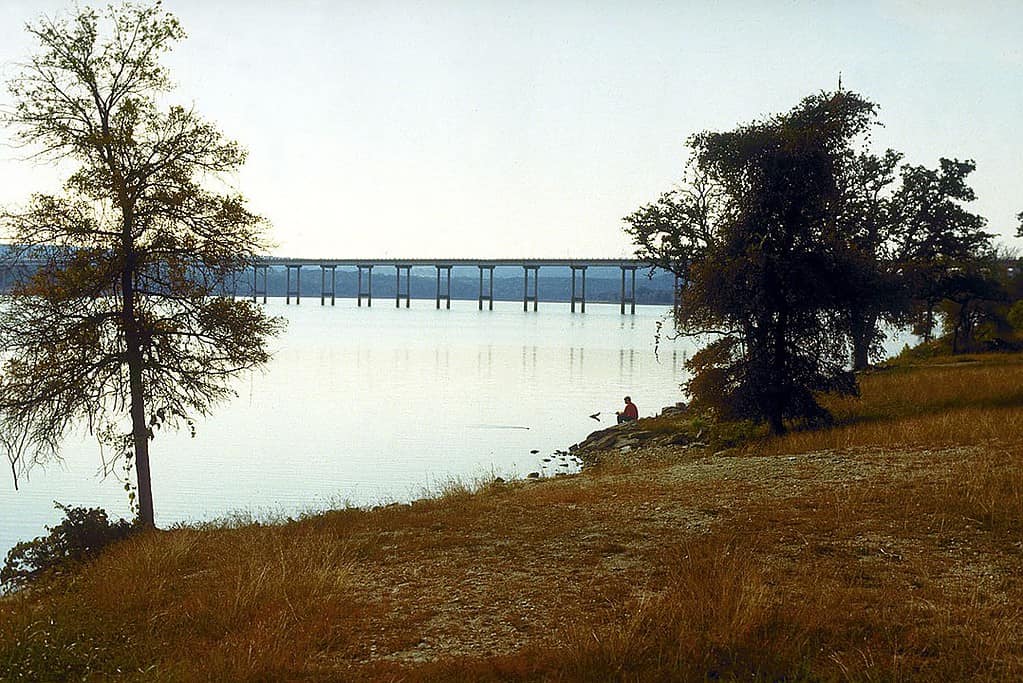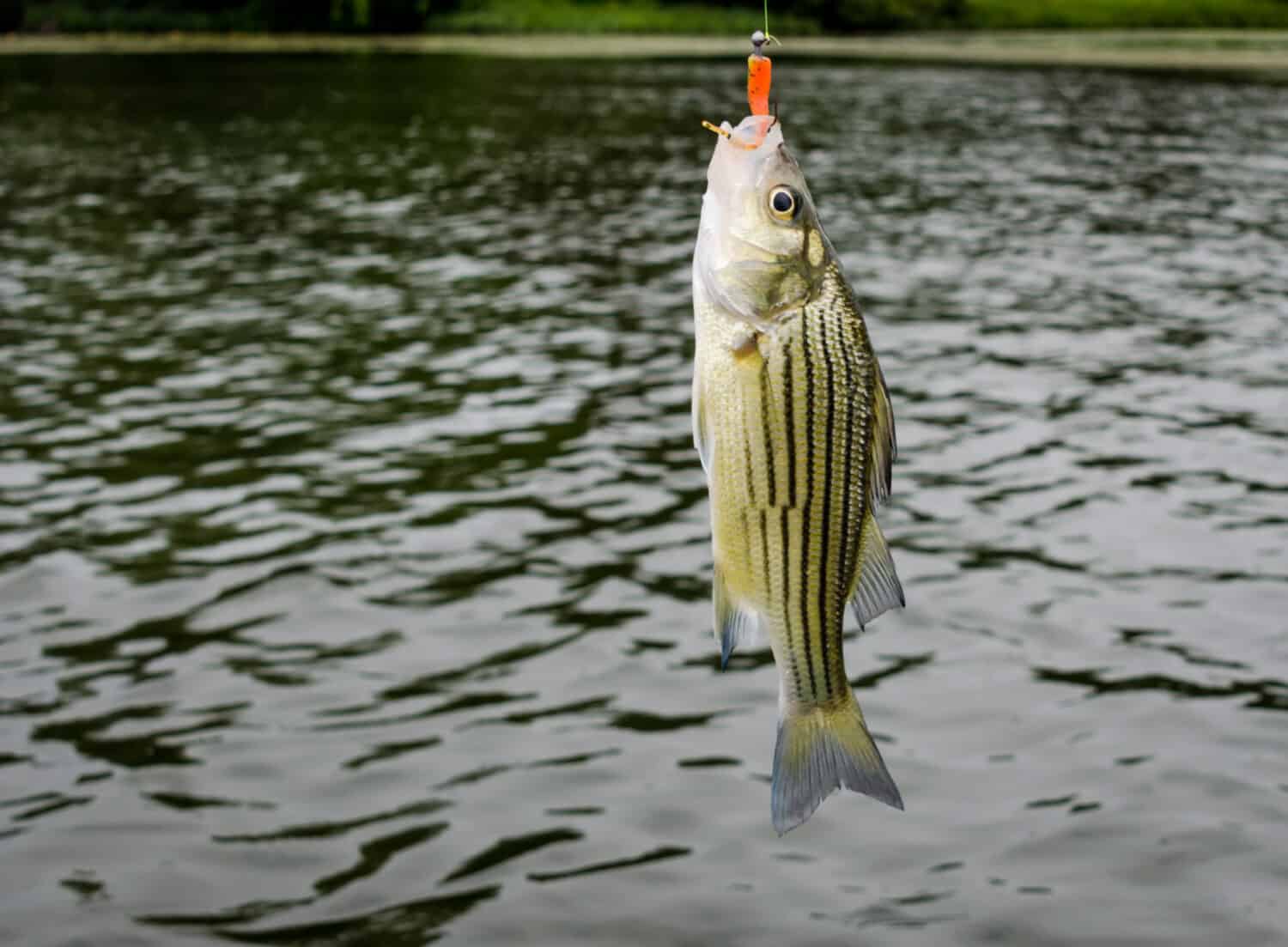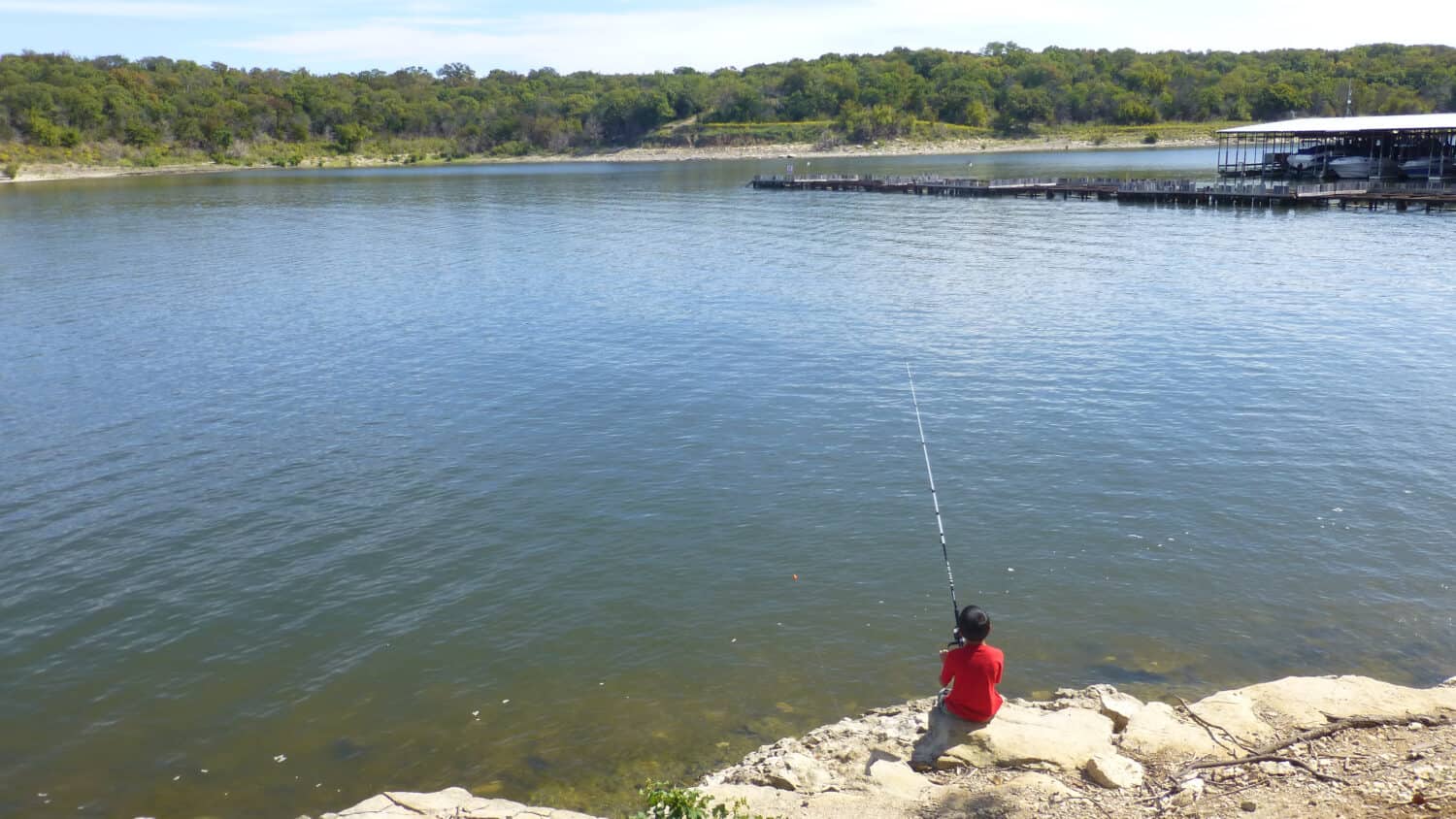Texas boasts over 7,000 lakes of various sizes, depths, and shapes within its borders encompassing 268,596 square miles. Of those watery scenic wonders, a few hundred are naturally created (typically known as “oxbow” lakes). Most are manmade and do double-duty as reservoirs. But if you’re seeking just 4 remote lakes in Texas to fish and swim, you won’t be disappointed.

This photo shows the shape of what a typical “oxbow lake” looks like from an aerial viewpoint. The vast majority of remote lakes in Texas do not have this distinctive ribbon shape.
©goran_safarek/Shutterstock.com
Many lakes here are situated close to metro areas, making them ideal for a quick day trip. They’re easily found throughout the state. However, Texas also has numerous off-the-beaten-path lakes located far away from crowds; you just have to look a bit harder for them! Fortunately, we’ve researched for you.
In this article, you’ll learn about four remote lakes in the Lone Star State. Generally speaking, only nearby know about these secret fun spots. Each lake not only caters to anglers of all skill levels but also offers enjoyment for swimmers seeking cool relief on hot Texas days.
Lake Theo
The 120-surface-acre Lake Theo is practically hidden in the Caprock Canyons State Park and Trailway located within Briscoe County, TX. The park is an excellent example of a gorgeous, rugged canyon country. It casts a spell on visitors with its natural beauty comprised of multi-colored vegetation, red cliffs and ridges, and jagged ravines juxtaposed against flat Texas plains.
Open year-round, Caprock Canyon State Park and Trailway is located about 100 miles southeast of the City of Amarillo. This is what is known as the Panhandle part of the state. The State of Texas bought the parkland in 1975 and opened it to the public in 1982. A meandering 1,217-acre Trailway is part of the park’s 15,313 acres. Lake Theo was created when a tributary of the Little Red River, Holmes Creek, was dammed as part of park development.
Lake Theo Fishing
Most people are unaware that little Lake Theo is stocked with a wide variety of fish; that’s a good thing for anglers looking for an under-fished place to throw in a line. The most-caught species are Largemouth Bass, White Crappie, Bluegill, and Yellow Perch, but other fish that excite anglers are caught from time to time.
Forget your fishing pole? No worries! You can rent one from the park’s headquarters office and, if any are still there when you arrive, you can even borrow poles (first come, first served). Rangers don’t give away bait but sometimes sell it. Ready to land your trophy fish? Then head out onto the waters in a small boat without an engine. Or, throw out your line from one of the piers around Lake Theo.
Other popular things to do in this remote park include: geocaching, riding bicycles and horses, camping, watching local bison and bats, no-wake boating, and going on picnics to oogle the canyons, plains, lake, and animals.
According to Texas Parks & Wildlife, giant bison, camels, horses, and mammoths used to graze in the park more than 12,000 years ago. Wolves and Black Bears formerly lived here, too. However, local ranchers got rid of those two species by the mid-20th century. Today, the park’s canyon lands are full of wildlife, ranging from bobcats, coyotes, deer, and antelope, to grey foxes, jackrabbits, and raccoons.

Lake Theo is located in Caprock Canyon State Park and Trailway and is famous for its 200-head Texas State Bison Herd.
©James_Gabbert/iStock via Getty Images
Bison and Snakes!
Notable and hard-to-miss inhabitants are the majestic bison, all part of the Texas State Bison Herd running free within a 10,000-acre area. In 1878 a local Texas cattleman and his wife established the herd (numbering at least 200 head these days). It is one of a handful of American bison herds that helped save the bison from extinction.
Moreover, 30-some snake species, over a dozen kinds of lizards, and more than 175 different bird species inhabit the park, too. For all these creatures, Lake Theo is a primary water source.
Make time to visit this remote lake in Texas all year round; you won’t be disappointed!
More Information
Park address: 850 State Park Rd., Quitaque, TX 79255
Lake Theo Location: See map; the lake is at the southern park border.
Hours: Daily, 8 a.m. to 10 p.m.
Entrance daily fee: $5 for adults 13 years or older; younger children are free. The group rate is $3 per person for all groups using day-use facilities.
Park info: (806) 455-1492; [email protected]; https://tpwd.texas.gov/state-parks/caprock-canyons.
Park reservations: (512) 389-8900.
Busy seasons: Spring, Summer, and Fall.
Caddo Lake
In East Texas, the 8,253-acre Caddo Lake State Park surprises visitors not accustomed to seeing its unusual Piney Woods ecosystem more commonly encountered in Louisiana. That’s because, for most Texans, swaths of Oak and Cedar are the most typical trees observed throughout the Lone Star State.
Yet, beyond its pine trees, the Harrison County park’s botanical jewel is the Big Cypress Bayou. This beautiful swamp waterway is very special as it’s home to the world’s largest Cypress tree forest. Millions of spiky Spanish Moss clusters hang in the other-worldly branches of thousands of tightly clustered trees, providing shade and homes to scores of animals and birds.
But there are way more water wonders to discover besides the bayou. On its west side is the 25,400-acre Caddo Lake, situated on the border between Texas and Louisiana. This is the largest naturally formed lake in Texas. That’s why it’s such a rarity amongst the state’s lakes. It’s also the second-largest natural lake in the American South and an internationally protected wetland.
Lake Caddo Fishing
This is a fun remote lake in Texas to fish and swim. One reason is that you never know what you’re going to catch due to the incredibly diverse fish population represented by at least 86 species! Since Caddo Lake is shared by Louisiana, you can fish using either a Texas or Louisiana fishing license. Enjoy fishing from a boat, or from one of the lake’s fishing piers, You can use some of the lighted fishing piers, or go out on an adventure with a boat.
Typically anglers can expect to bag Catfish, Crappie, Largemouth Bass, Bream, and Chain Pickerel. Largemouth Bass fishing is popular at the lake, and anglers find the Spring season is the best to fish for them, especially during March.
If you’re extremely lucky, you may just see a prehistoric fish swimming around called the American Paddlefish. An inhabitant of the region’s wetlands area for more than 300 million years, this rare species existed well before land dinosaurs stomped around. Paddlefish are massive creatures. They can weigh up to 200 pounds, and grow to seven feet in length. They also can live over 20 years. Be aware it’s illegal to catch this endangered species in Texas.

Caddo Lake is the largest naturally formed lake in Texas. It’s next to Big Cypress Bayou, a swamp supporting the world’s largest Cypress tree forest.
©Daniel Mullins/Shutterstock.com
Swimming, Snakes and Alligators
Can you swim here? Yes, people sometimes do jump around in its waters year-round, but with caution. There are no swimming beaches, and all the shores are privately owned. However, all of Caddo Lake’s waters are public. So, too, are the 42 miles of marked boat channels. People who know the lake strongly advise visitors to only traverse the waters within those channels, as it’s very easy to get lost if you boat outside marked boundaries.
Since the average depth of the lake’s waters is very shallow, 8-10 feet at best, and the lake bottom very muddy, swimming can be challenging. Therefore, probably a better idea is to take a bass-type boat out into the connecting waters of the Big Cypress Bayou. This area is where the deepest parts average about 20 feet.
But there are other things to consider if you’re keen on swimming in this remote lake in Texas: alligators. Fortunately, these large reptiles are said to be rarely encountered in the area. Then there’s the snakes! At least 32 species live around and in Caddo Lake, including two types of rattlesnakes and Eastern Coral snakes.
Caddo Lake wetlands attract dozens of different types of bird species, too. Some live here year-round while others just visit while on a migratory path. Species observed at different types of the year range from ducks, geese, and swans, to wood warblers, hummingbirds, grosbeaks, and buntings.
Caddo Lake State Park offers a variety of other outdoor activities. They include canoeing, launching a boat, hiking 2.5 miles of trails, geocaching, or going on picnics. Park accommodations include 46 campsites, and range from lodges, cabins, and sites for tents, to full-hookup RV campgrounds.
More Information
Park address: 245 Park Rd 2, Karnack, TX 75661
Hours: Daily, 6 a.m. to 10 p.m.
Park info/reservations: (903) 679-3351
Entrance daily fee: $4 per person 13 years and older; under 12, free.
Office & Gate: Open daily 8:15 a.m. to 4:45 p.m.; hours vary.
Busy seasons: Spring, Summer, and Fall.
Stillhouse Hollow Lake
Another Texas lake to fish and swim in is Stillhouse Hollow Lake. Completed in 1968 by the U.S. Army Corps of Engineers primarily as a flood control reservoir on the Lampasas River, the lake remains a vital source of abundant water for numerous surrounding communities.
However, over the years, the reservoir has established itself as a multi-purpose destination within Bell County, too, with fishing and boating topping the list of fun things to do here.
Part of its allure is the fact the lake is large, with a surface area spanning 6,429 acres. Additionally, its blue waters are relatively clear for lake waters and can be deep in some places since the reservoir was constructed with a maximum depth of 107 feet. A picturesque rocky shoreline dominates the lake’s main area.
Fishing and Swimming
Anglers say great fishing spots are abundant at Stillhouse. Large populations of stocked Largemouth Bass draw happy anglers. Other abundant species of fish swimming around here are Smallmouth Bass, White Bass, Catfish, and Channel Catfish.

Stillhouse Hollow Lake is a manmade reservoir on the Lampasas River, located five miles southwest of the small town of Belton, TX.
©Tricia Daniel/Shutterstock.com
Swimming is allowed, but only recommended at designated swim beaches along the shoreline. Those who like to go snorkeling, wading, and scuba diving can do so at their own risk, and only at special areas deemed safer than others in the park. The attraction’s Dana Peak Park has 32 picnic tables, plus a swim beach and boat ramp. Nearby is Stillhouse Park, offering a beach area with water access from each of its 38 picnic sites.
Relatedly, the Marina at this remote lake in Texas offers outdoor fishing 24 hours a day (Tuesday through Sunday). It also sells bait. On the weekends you can rent a kayak, canoe, or paddleboard from Scuba Divers Paradise, a full-service dive shop floating on the lake next to the Marina.
No matter what you’re doing in or on the water, wear a life jacket to stay safe. Not surprisingly, prohibited activities include jumping, diving, and swinging from natural and manmade structures into the lake. As with other Texas lakes, during the state’s infamous droughts water levels can get extremely low. That’s when swimmers should be extra careful by looking out for submerged trees, stumps, and similar hazards.
Camping and Other Activities
Like to camp? Then you’ll want to know about Union Grove Park, one of just two campgrounds you can reserve around the lake. It offers both tent and RV camping sites (water and electric hookups available). Be sure to check out boating sports, hiking, horseback riding, and biking opportunities before you leave. One of the best places to hike to take in all the beautiful scenery is Chalk Ridge Falls. It’s located near the edge of Stillhouse Hollow Dam. The year-round flowing waterfalls attract many admirers to this area.
Many visitors enjoy bird watching year-round due to the presence of close to 200 bird species, such as hawks and various songbirds, plus migrating geese, ducks, and Great Blue Herons passing through in the winter. Sometimes a rare Bald Eagle will make an appearance. The most notable larger animals at Stillhouse Hollow Lake? Alligators! Although rarely seen, people do spot them a few times a year.
More Information
Address: 3740 FM 1670, Belton, TX, 76513.
Contact lake headquarters: (254) 939-2461; www.swf-wc.usace.army.mil/stillhouse
Marina Phone: (254) 939-5741
Entrance daily fee: $5 per vehicle, unless presenting an access card.
Hours: Park gates open at 6 a.m. and close at 10 p.m. each day.
Busy seasons: Spring, Summer, and Fall.
Map of Stillhouse Hollow Lake

View of the bridge across Stillhouse Hollow Lake, TX, located about seven miles from the flood control dam that provides water and creates recreational opportunities for residents of nearby communities.
Lake Texoma
For residents of the Dallas-Fort Worth metroplex, Lake Texoma is a remote lake in Texas that is ideal as a day-trip destination. Geographically unique, the lake is along the border of Texas and its northern neighbor. About 80 percent of its 93,000 watery acres are located in Lake Texoma State Park in Oklahoma; with the remainder found in Eisenhower State Park in the Lone Star State.
Specifically, this manmade reservoir lake was created with the establishment of the Denison Dam on the Red River. It is part of both Grayson County, TX, and Bryan County, OK. Due to the structure’s large size, Lake Texoma is known as one of America’s largest reservoirs.
Although relatively isolated from major cities, it’s a popular lake. About six million visitors a year make the trek to Lake Texoma to enjoy its numerous and beautiful natural attributes, and many outdoor things to do.

©iStock.com/asiantiger247
A beautiful sunset like this is not a rarity at picturesque Lake Texoma, TX.
Paradise for Striper Bass Fishing
Fishing is a hugely popular sport at Lake Texoma. Over 70 different fish species live here. Individuals with Texas fishing licenses are allowed to fish in the Texas areas of the reservoir. Another option is to buy a Lake Texoma license ($12) to fish all the waters in Oklahoma and Texas. Predominantly caught fish species include Blue and Channel Catfish; Bluegill, Black and White crappies; and Largemouth, Smallmouth, and Spotted Bass.
Lake Texoma also is well-known for its population of Striper Bass, a species not typically found proliferating in Texas reservoirs without the help of restocking efforts. This ocean species, introduced in 1965 by Oklahoma’s Wildlife Conservation Department, reproduces naturally in the reservoir’s waters. Its large size, fighting strength (and excellent taste when grilled) make Striped Bass a favorite game fish amongst thousands of anglers seeking its capture each year.
These “Stripers” are what draw countless professional and amateur fishermen alike to enter the many annual fishing tournaments held at Lake Texoma. The fish is the reason the lake is nicknamed “Striped Bass Fishing Capital of the World.”
Boats Easy to Rent
For all your fishing needs, there’s a boat to be found for rent at any of a dozen or more marinas and resorts scattered around Lake Texoma’s perimeter. Many of the places also rent kayaks, paddleboards, and wakeboards. For more adventure, try booking a trip with one of the more than two dozen charter companies. They make fishing dreams come true for groups of all sizes. Some of the more popular operations are Gone Fishin’ Guide Service, Staley Adventures, and Bill Miller Texoma Striper Guide.
Moreover, there are a plethora of professional fishing guides working at Lake Texoma who are eager to share their angler knowledge and boats with you.
Swimmers Love the Party Islands
What about swimming? There are plenty of sandy beach options along Lake Texoma’s 580 miles of shoreline. The “designated” place to swim is a beach at Ben’s Campground, located in the Rooster Creek area near Catfish Bay Marina. However, there are a great number of great swimming spots to be explored along the meandering shoreline.
Be aware that, as with most lake beaches in Texas, life jackets are recommended to be worn when in the water. This is to prevent mishaps due to walking on the uneven lake bottom submerged natural debris, or swimming in unexpectedly deep water. And watch out for the snakes!

Striped Bass, typically found in the North Atlantic Ocean, is one of the most popular species of game fish attracting anglers of all skill levels to Lake Texoma, TX.
©HildeAnna/Shutterstock.com
Another popular aquatic playground is aptly named the “Lake Texoma Party Islands.” This area is comprised of six small sandbar islands that boats can only be reached. Note that the Islands are only accessible by boat. It is the best place, many visitors say, for swimming, picnics and parties. As the water surrounding the sandbars is shallow, it is an ideal no-stress, safe swim beach.
Water Taxis Add to the Fun
Don’t have a boat to get here? No problem! For the easiest no-fuss transportation option, simply call Texoma Water Taxi, a private operation providing water taxi services and fun rides to natural or manmade fun spots on Lake Texoma. Another good transportation choice is Anchor Up Island Shuttle, a water taxi service taking people to the party islands (and thoughtfully giving them sand-building tools, umbrellas, and beach chairs). This enterprise also offers two 60-minute tours: one is a sunset ride to/from the Marina; the other is a general tour of Lake Texoma.Sunset at Lake Texoma.
Visitors enjoy myriad other fun things to do at Lake Texoma. These activities include beach games, picnicking, all kinds of water sports, camping, hiking, eating at shoreline eateries, wildlife photography, and simply observing the area’s natural beauty and wildlife. Birdwatching is popular here as well. Larger animals live near the lake, too, such as deer, squirrels, turkeys, rabbits, feral hogs, and rabbits.
Explore Two Large Nature Areas
Specifically, the majority of Lake Texoma’s natural wildlife wonders are found within its two major nature areas.
One is the Tishomingo National Wildlife Refuge situated on Oklahoma’s land.
The other on the lake’s Texas side is the 11,000-acre Hagerman National Wildlife Refuge, known as the biggest public expanse of nature in the state. Both are remote places to visit for birding, hiking and just relaxing away from modern-day crowds and congestion.
More Information
Address of Eisenhower State Park, TX: 50 Park Road, Denison, TX 75020-4878
Eisenhower contact info: (903) 465-1956, reservations (512) 389-8900.
Hours: Daily, 8 a.m. to 5 p.m.
Entrance daily fee: $5 for adults 13 years or older; younger children are free.
Private resorts & concessions info: Lake Texoma Association, (580) 564-2334
Busy seasons: Spring, Summer, and Fall.
List of Lake Texoma resorts, marinas, and inns

Fishing in Lake Texoma at Eisenhower State Park in Texas is a popular pastime for locals, and visitors lucky enough to find this hidden water gem.
©NicholasGeraldinePhotos/Shutterstock.com
A Final Note
Before planning on exploring these 4 remote lakes in Texas to fish and swim, it’s wise to first contact the people working at the site’s headquarters.
At the very least, you’ll want to check the predicted weather conditions for the period you will be visiting, and find out if there is enough water in the lake to enjoy fishing and/or swimming. Also, since Texas fishing regulations can and do change throughout the year ask about the most recent rules you’ll need to follow. For example, they regulate the number and size of fish you can keep, and the dates and locations you’re allowed to fish.
When swimming in any natural or manmade lake, both people and pets should avoid contact with any water showing algae “mats,” scum layers or colored surface films, or emitting bad smells. Instead, opt to swim in areas that are not stagnant and show some water movement. Doing this will cut down the chances of ingesting or coming in contact with water organisms that can produce dangerous toxins.
The photo featured at the top of this post is © Victoria Ditkovsky/Shutterstock.com
Thank you for reading! Have some feedback for us? Contact the AZ Animals editorial team.







